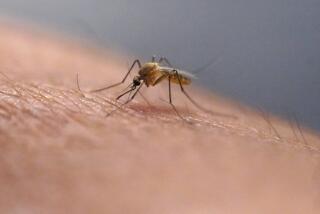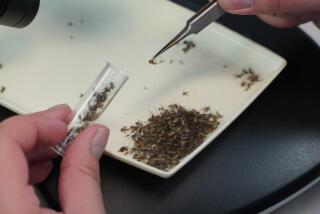Are You Raising Mosquitoes in the Backyard?
- Share via
Just where do mosquitoes come from in an urban area like Los Angeles? The swamps that were reported by the first Spanish explorers are long gone, and our streams and rivers have been channeled, so where do they breed?
In backyards for the most part, and sometimes in the smallest bodies of water, things like flower pots, watering cans, the bilge of your ski boat or even in an empty soft-drink can. At this time of year, it is customary to receive a health-hazard warning from the various Vector Control Districts or Mosquito Abatement Districts in Southern California to clean up these areas.
When the weather is warm as it was recently, mosquitoes can complete their entire life cycle in as few as four or five days, so even a birdbath that is not rinsed out every few days can spawn a swarm.
Look for Standing Water
“Are you raising mosquitoes?” is the question they ask, and most likely we all are. They suggest looking for any standing water in the garden and dump it out and then invert the container or otherwise keep it from becoming filled again.
Their lists of possible sources is almost amusing, because it includes so many innocuous containers: tin cans, saucers under potted plants, old tires, toys, clogged roof gutters, wading pools, birdbaths, rain barrels, over-irrigated lawns, house cooler units and holes in trees. The last of these should be cleaned out and filled with the packaged concrete used for repairing driveways or walls, for the health of the tree as well as the neighborhood.
One of the most common breeding grounds is a little harder to deal with--street gutters that don’t drain quickly. Talk to your city’s street maintenance people, or mosquito abatement or vector control district personnel. If you have seen a truck driving slowly down your street spraying something into the gutters, they are after the mosquito larva.
Hatch From ‘Egg Rafts’
The larva hatch from a batch of floating eggs, called “egg rafts,” which contain 100 to 400 individual eggs. The larva, called “wigglers” for the way they propel themselves, are easy to spot, being shaped like a skinny comma.
In ornamental ponds or even rain barrels, you can best control them with fish, which are very thorough. Ordinary goldfish--the kind you buy to feed snakes, or win at a school carnival--will live in most pools, even those the size of a half-barrel. Even sturdier are the “mosquito fish,” which look like guppies. These are often available from mosquito abatement or vector control districts and can reportedly live in as little as three inches of water.





